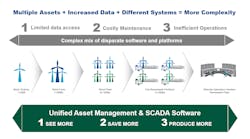Virtual Reality: Microgrids, VPPs Mutually Boost Each Other's Case
(Editor's Note: Story originally posted in November 2023)
No virtual power plant (VPP) is a microgrid, but any connected microgrid can be part of a VPP.
Ever the twain shall meet. The decentralization, democratization, and fragmentation of the power grid are yielding newer and more complex energy combinations these days, making room for these two very different energy assets to act together.
Microgrids are relatively simple to comprehend. They are smaller, on-site power resources that can connect and yet also operate independently from the utility system. VPPs, on the other hand, are meant to benefit the larger grid in times of power capacity duress.
More and more, though, one can aid the other in scaling up and contributing to a greater portion of the clean energy portfolio.
The Value of Flexible Capacity
The proliferation of grid-connected devices — from smart thermostats, rooftop solar, residential battery storage, generators, and microgrids — has created a new dynamic and revenue opportunity for distributed energy resources (DERs). Using software and digital tools, a wide, disparate array of DERs can be pooled and directed to create virtual power plants that can be used in demand response and peak load times of need.
“The transition to a more distributed, renewable grid is increasing the value associated with flexible capacity, and the markets and utilities themselves are recognizing this,” Don McPhail, vice president of product for energy software firm Uplight, said in an interview with Microgrid Knowledge. “As a result, they have increased their efforts to transform and digitize the systems that enable the valuing and management of more resources into the grid planning [and] operations.
“These two factors mean there is value to capture through VPPs, and the cost to unlock that value is now a relatively low marketing and enrollment cost as opposed to higher barriers associated with greenfield technology and capex costs,” McPhail added.
Use Cases for Utilities and Beyond
Virtual power plants are both kind of invisible and yet appear to be popping up everywhere. Uplight is working with Pacific Gas & Electric on a smart thermostat demand response program.
AutoGrid, owned by Schneider Electric, is working with Puget Sound Energy in western Washington to create a VPP program, while Texas grid operator ERCOT and many others are piloting the aggregated and digitally operated use of DERs to help offset utility grid challenges as the pressure for electrification collides with weather events and higher customer demand.
“The VPP solution allows participating customers to receive monetary incentives for sharing assets with the grid and/or curtailing usage, something that’s financially beneficial for the community as well as helping the utility efficiently manage increasing electricity demand,” AutoGrid CEO Ruben Llanes said in response to Microgrid Knowledge’s emailed questions.
VPPs as part of the Microgrid and DER Value Chain
In Focus this April at Microgrid 2024 in Baltimore
Join us for the Revolution in Energy
Not all of the VPP initiatives are just utility- or state-based. The Federal Energy Regulatory Commission (FERC) several years ago passed Order 2222, requiring independent and regional transmission operators to eventually allow aggregated DERs in market participation.
FERC Order 2222 is still having growing pains, but the future is bright for VPPs and, by extension, microgrids as a result of the infusion of federal, state, and local financial support regarding on-site power resiliency and carbon reduction goals. Not every DER is a microgrid, but every microgrid is a DER ready to be utilized for the common good.
“Microgrids and VPPs have very different markets and use cases, but there is some overlap where the two market opportunities can come together,” Uplight’s McPhail pointed out. “In terms of parallels, both are focused on a connected set of energy devices and DERs to then be orchestrated to create value that is cheaper and avoids the need for alternative traditional investments, such as centralized generation.”
A Mutual Scaling Up of Microgrids and VPPs
In addition, electrification of the transportation and residential sectors, which could reduce carbon within two areas of the economy that emit more than a third of greenhouse gas emissions nationwide, can drive a mutual scaling up of both VPPs and microgrids. Microgrids can provide on-site power resiliency to charging stations, while digital redeployment of energy assets can deliver broader protection against potential grid challenges such as capacity not meeting demand.
“VPPs are a more affordable answer to future electricity demand spikes because they rely on non-utility-owned grid assets, often installed by prosumers [customers that both produce and consume the energy],” AutoGrid’s Llanes noted. “As mass electrification advances and new asset types and vendors come online, the flexibility and scale of multi-asset VPPs extend even further.”
As Uplight's McPhail added, the financial benefit to VPP to microgrid-DER owners/operators is hard to calculate and depends on the specific microgrid site’s situation, but it will almost certainly benefit from factors such as avoided connection and equipment costs as well as the economic benefit of increased uptime for commercial operation.
“VPPs can create another value stream to a microgrid when they aren’t being leveraged for their primary use case,” McPhail said. “This can make them more commercially viable or even generate some additional revenue for the microgrid owner. And the VPP has turned the microgrid from what was possibly a ‘net neutral’ to the wholesale grid into a ‘net positive’ by unlocking its value with the rest of the VPP fleet."








